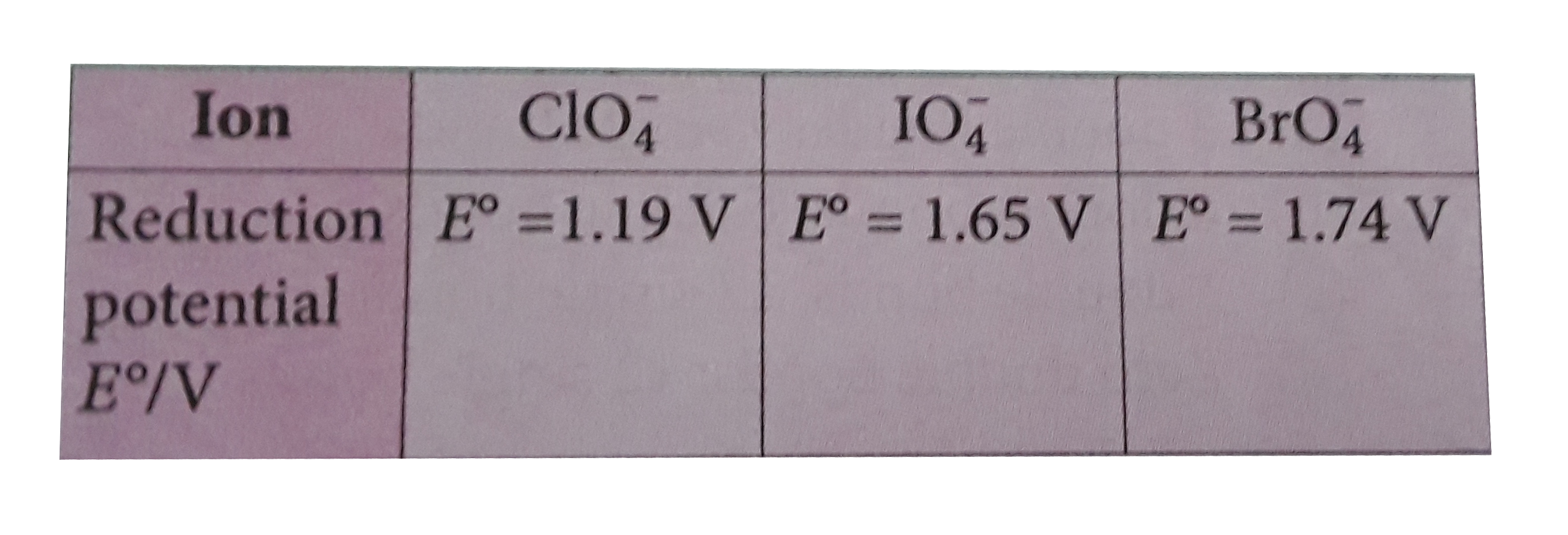Complete Solutions to NCERT Exemplar of chapter THE P-BLOCK ELEMENTS of Class 12 book with complete answers and questions
| Class 12 | CHEMISTRY |
| Chapter | THE P-BLOCK ELEMENTS |
| NCERT FINGERTIPS | NCERT Exemplar |
| Number Of Questions | 27 |
| Academic Year | 2023-24 |
On addition of conc. `H_(2)SO_(4)` to a chloride salt, colourless fumes are evolved but in case of iodide salt, violet fumes come out. This is because
View SolutionIn qualitative analysis when `H_(2)S` is passed through an aqueous solution of salt acidified with dil. HCl, a black precipitate is obtained. On boiling the precipitate with dil. `HNO_(3)`, it forms a solution of blue colour. Addition of excess of aqueous solution of ammonia to this solution gives
View SolutionIn a cyclotrimetaphosphoric acid molecule, how many single and double bonds are present ?
View SolutionWhich of the following elements can be involved in `p pi- d pi` bonding ?
View SolutionWhich of the following pairs of ions are isoelectronic and isostructural?
View SolutionAffinity for hydrogen decreases in the group from fluorine to iodine. Which of the halogen acids should have highest bond dissociation enthalpy?
View SolutionBond dissociation enthalpy of E-H (E=element) bond is given below.

Which of the following compounds will act as strongest reducing agent?
View SolutionOn heating with concentrated NaOH solution in an inert atmosphere of `CO_(2)`, white phosphorus gives a gas. Which of the following statements is incorrect about the gas ?
View SolutionWhich of the following acids forms three series of salts?
View SolutionStrong reducing behaviour of `H_(3)PO_(2)` is due to
View SolutionOn heating lead nitrate forms oxides of nitrogen and lead. The oxides formed are :
View SolutionWhich of the following elements does not show allotropy ?
View SolutionMaximum covalency of nitrogen is :
View SolutionWhich of the following statements is wrong?
View SolutionA brown ring is formed in the ring test for `NO_(3)^(-)` ion. It is due to the formation of
View SolutionElements of group 15 form compounds in `+5` oxidatin state. However, bismuth forms only one well characterised compound in `+5` oxidation state. The compound is
View SolutionOn heating ammonium dichromate and barium azide separately we get
View SolutionIn the preparation of `HNO_(3)`, we get NO gas by catalytic oxidation of ammonia . The moles of No produced by the oxidation of two moles of `NH_(3)` will be ……… .
View SolutionThe oxidation state of central atom in the anion of compound `NaH_(2)PO_(2)` will be . . . . . . . . .
View SolutionWhich of the following is not tetrahedral in shape ?
View SolutionWhich of the following are peroxoacids of sulphur ?
View SolutionHot conc. `H_(2)SO_(4)` acts as moderately strong oxidising agent. It oxidises both metals and non-metals. Which of the following elements is oxidised by conc. `H_(2)SO_(4)` into two gaseous products ?
View SolutionA black compound of manganese reacts with a halogen acid to give greenish yellow gas. When excess of this gas reacts with `NH_(3) an unstable trihalide is formed. In this process the oxidation state of nitrogen changes from . . . . . . . . . .
View SolutionIn the preparation of compounds of Xe, Bartlett had taken `O_(2)^(+) Pt F_(6)^(-)` as a base compound. This is because
View SolutionIn solid state, `PCl_(5)` is a……..
View SolutionReduction potentials of some ions are given below. Arrange them in decreasing order of oxidising power.

View SolutionWhich of the following is isoelectronic pair ?
View Solution
NCERT Exemplar questions and complete solutions for chapter THE P-BLOCK ELEMENTS of NCERT FINGERTIPS CHEMISTRY (HINGLISH) of Class 12
All Exercises from NCERT FINGERTIPS Class 12 CHEMISTRY THE P-BLOCK ELEMENTS
- Ammonia
- Assertion And Reason
- Chlorine
- Dinitrogen
- Dioxygen
- Group 15 Elements - The Nitrogen Family
- Group 16 Elements - The Oxygen Family
- Group 17 Elements - The Halogen Family
- Group 18 Elements - The Noble Gases
- Higher Order Thinking Skills
- Hydrogen Chloride
- Interhalogen Compounds
- NCERT Exemplar
- Nitric Acid
- Oxides Of Nitrogen
- Oxoacids Of Halogens
- Oxoacids Of Phosphorus
- Oxoacids Of Sulphur
- Ozone
- Phosphine
- Phosphorous : Allotropic Forms
- Phosphorus Halides
- Simple Oxides
- Sulphur : Allotropic Forms
- Sulphur Dioxide
- Sulphuric Acids